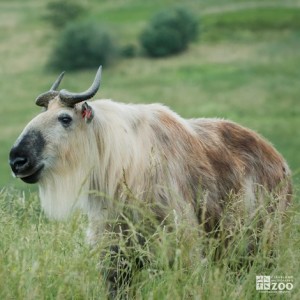 The Takin is a goat-antelope found in the eastern Himalayas. It rivals the muskox as the largest and stockiest of the subfamily Caprinae. They have short legs with large, two-toed hooves, and a highly developed spur. The body is stocky and the chest is deep. The large head is made more distinctive by the long, arched nose, and stout horns that are ridged at the base and can reach 64cm (25in )in length. Both sexes have small horns which run parallel to the skull and then turn upwards in a short point, these are around 30cm (12in) long. The long, shaggy coat is light in color, with a dark stripe along the back, and males (bulls) also have dark faces. Four subspecies of Takin (Golden, White, Sichuan and Bhutan) are currently recognised and these tend to show a variation in coat color. Their thick wool often turns black in color on their undersides and legs. The overall coloration ranges from dark blackish to reddish-brown suffused with grayish-yellow in the eastern Himalayas to lighter yellow-gray in the Sichuan Province to mostly golden or (rarely) creamy-white with fewer black hairs in the Shaanxi Province. The hairs of the species can range from 3 cm (1.2 in), on the flanks of the body in summer, up to 24 cm (9.4 in) on the underside of the head in winter. They stand 97 to 140 cm (38 to 55 inches) at the shoulder and measure a relatively short 160-220 cm (63-87 in) in head-and-body length. The tail adds only 12 to 21.6 cm (4.7 to 8.5 inches). Reported weights are variable, but the species is quite heavy. Reports indicate the males are slightly larger, weighing 300-350 kg (660-770 lb) against 250-300kg (550-660 lb) in females. Rather than localised scent glands, the Takin has an oily, strong-smelling substance secreted over the whole body. This is likely the reason for the swollen appearance of the face. Their only confirmed natural predator is the snow leopard, although both bears and wolves have been reported to prey on Takin. The Takin is the national animal of Bhutan.
The Takin is a goat-antelope found in the eastern Himalayas. It rivals the muskox as the largest and stockiest of the subfamily Caprinae. They have short legs with large, two-toed hooves, and a highly developed spur. The body is stocky and the chest is deep. The large head is made more distinctive by the long, arched nose, and stout horns that are ridged at the base and can reach 64cm (25in )in length. Both sexes have small horns which run parallel to the skull and then turn upwards in a short point, these are around 30cm (12in) long. The long, shaggy coat is light in color, with a dark stripe along the back, and males (bulls) also have dark faces. Four subspecies of Takin (Golden, White, Sichuan and Bhutan) are currently recognised and these tend to show a variation in coat color. Their thick wool often turns black in color on their undersides and legs. The overall coloration ranges from dark blackish to reddish-brown suffused with grayish-yellow in the eastern Himalayas to lighter yellow-gray in the Sichuan Province to mostly golden or (rarely) creamy-white with fewer black hairs in the Shaanxi Province. The hairs of the species can range from 3 cm (1.2 in), on the flanks of the body in summer, up to 24 cm (9.4 in) on the underside of the head in winter. They stand 97 to 140 cm (38 to 55 inches) at the shoulder and measure a relatively short 160-220 cm (63-87 in) in head-and-body length. The tail adds only 12 to 21.6 cm (4.7 to 8.5 inches). Reported weights are variable, but the species is quite heavy. Reports indicate the males are slightly larger, weighing 300-350 kg (660-770 lb) against 250-300kg (550-660 lb) in females. Rather than localised scent glands, the Takin has an oily, strong-smelling substance secreted over the whole body. This is likely the reason for the swollen appearance of the face. Their only confirmed natural predator is the snow leopard, although both bears and wolves have been reported to prey on Takin. The Takin is the national animal of Bhutan.
Location: Asian Highlands
Share:
Range
E. Tibet, Sikkim, Bhutan, N. Assam, N. Burma, and Central & Southern China
Habitat
Dense thickets near the upper limit of tree growth at around 3,000 to 14,000 feet above sea level.
Conservation Status
Vulnerable
Primary Threats
Human Wildlife Coexistence
Gestation
200 to 220 days
Litter
Normally 1
Behavior
The takin prefers dense tickets near the upper limit of tree growth. It makes narrow paths through this thick growth, which is used regularly in passing to and from grazing grounds and salt licks. It moves slowly and deliberately, but can leap nimbly from rock to rock on rough slopes. There are regular seasonal migrations between alpine areas in summer and forested valleys in winter. Takins sometimes spend much of the day in dense vegetation, and emerge in late afternoon and early morning to feed. On cloudy and foggy days it may remain active throughout the day. They are reported to be generally herbivores, and primarily browsers. They may push over or break saplings 3 to 4 inches in diameter. They require a substantial amount of minerals, and have been known to travel long distances to reach salt licks, where they may congregate in large numbers and remain for several days. They gather in large herds during the summer, but in winter disperse into smaller bands for movement to lower elevations. When alarmed an individual gives a warning cough to alert others, and they quickly dash for the safety of dense underbrush.
Reproduction
Birth weights range from 11 to 15 pounds. There is normally a single kid, and within 3 days it is able to accompany its mother anywhere.
Wild Diet
Forbs and deciduous leaves in summer; twigs & evergreen leaves in winter.
Zoo Diet

